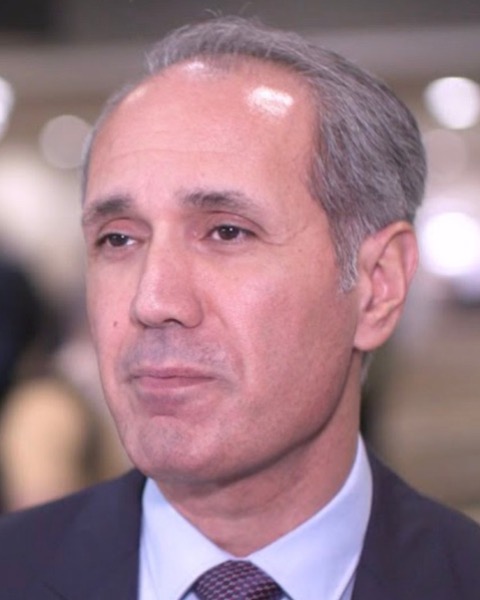Oral Abstract Session
OA – 01: Talquetamab (tal) + Daratumumab (dara) + Pomalidomide (pom) in Patients (pts) With Relapsed/Refractory Multiple Myeloma (RRMM): Results from the Phase 1b TRIMM‑2 Study
Friday, September 27, 2024
9:00 AM - 9:12 AM East Coast USA Time
Location: Plenary Hall, Pavilion 3

Nizar J. Bahlis, MD
Associate Professor of Medicine - Hematology and Bone Marrow Transplantation
Arnie Charbonneau Cancer Institute - University of Calgary
Calgary, Alberta, Canada
Speaker(s)
Introduction: Tal is the first approved GPRC5DxCD3 bispecific antibody (BsAb) for triple-class exposed RRMM. The immunomodulatory effects of dara+pom may potentiate the efficacy of tal. Initial TRIMM-2 results showed that dara + tal 0.4 mg/kg weekly (QW) or 0.8 mg/kg every other week (Q2W) had promising efficacy, and a safety profile consistent with the respective monotherapies. We present results from pts who received tal+dara+pom in TRIMM‑2.
Methods: Pts had MM, ≥3 prior lines of therapy (LOT; including a proteasome inhibitor [PI] and immunomodulatory drug [IMiD]) or were double refractory to a PI and IMiD and had not received anti-CD38 therapy in ≤90 days. Pts received tal 0.4 mg/kg QW or 0.8 mg/kg Q2W + dara 1800 mg + pom 2 mg (starting cycle 2). AEs were graded per CTCAE v5.0; cytokine release syndrome (CRS) and immune effector cell–associated neurotoxicity syndrome (ICANS) were graded per ASTCT guidelines. Responses were assessed per IMWG criteria.
Results: As of April 10, 2024, 77 pts had received tal+dara+pom (median follow-up: 17.5 months [mo]). Median prior LOT was 6 over a median of 6.8 years since diagnosis. At baseline, 26.2% had high-risk cytogenetics and 23.4% had extramedullary disease. Most pts were penta-drug exposed (68.8%) and triple-class refractory (77.9%). Prior treatments included anti-CD38 (93.5% [83.1% refractory]; dara (90.9% [80.5%]), IMiD (100% [97.4%]; pom, 83.1% [75.3%]), chimeric antigen receptor-T cell (31.2%), and BsAb (39.0% [37.7%]) therapies. Median time since last exposure was 474 days (d) for dara and 385 d for pom. There were no dose-limiting toxicities. All pts had ≥1 AE (94.8% grade [gr] 3/4), most commonly dysgeusia (79.2%; NA gr 3/4), neutropenia (77.9%; 68.8% gr 3/4), CRS (74.0%; all gr 1/2), dry mouth (64.9%; 2.6% gr 3/4), and fatigue (57.1%; 5.2% gr 3/4). Median onset of CRS was 1 d after tal; median duration was 2 d. ICANS occurred in 3.9% (gr 3/4 1.3%). Infections occurred in 74.0% (29.9% gr 3/4); onset of most gr ≥3 infections occurred within the first 6 months (18/23 events). 5.8% of pts discontinued tal due to AEs. Two pts had gr 5 AEs (sepsis and hemorrhagic transformation stroke). ORR was 81.8%; 53.2% had a complete response or better. Median DOR was 22.1 mo (95% CI, 13.6–27.0). Median time to first response was 1.0 mo (range, 0.9–6.7). Median PFS was 15.5 mo (95% CI, 11.7–24.4). Responses were deep and durable in anti-CD38 refractory and prior T-cell redirection–exposed pts. Preliminary data showed that tal serum concentrations were generally within the same range as tal monotherapy.
Conclusions: In heavily pretreated pts with RRMM who were mostly dara and pom refractory, tal+dara+pom showed promising depth and durability of response. The safety profile was consistent with the known safety profiles of each respective agent. Results support the versatility of tal as a combination partner and warrant further investigation of tal in combination with dara or pom.
Methods: Pts had MM, ≥3 prior lines of therapy (LOT; including a proteasome inhibitor [PI] and immunomodulatory drug [IMiD]) or were double refractory to a PI and IMiD and had not received anti-CD38 therapy in ≤90 days. Pts received tal 0.4 mg/kg QW or 0.8 mg/kg Q2W + dara 1800 mg + pom 2 mg (starting cycle 2). AEs were graded per CTCAE v5.0; cytokine release syndrome (CRS) and immune effector cell–associated neurotoxicity syndrome (ICANS) were graded per ASTCT guidelines. Responses were assessed per IMWG criteria.
Results: As of April 10, 2024, 77 pts had received tal+dara+pom (median follow-up: 17.5 months [mo]). Median prior LOT was 6 over a median of 6.8 years since diagnosis. At baseline, 26.2% had high-risk cytogenetics and 23.4% had extramedullary disease. Most pts were penta-drug exposed (68.8%) and triple-class refractory (77.9%). Prior treatments included anti-CD38 (93.5% [83.1% refractory]; dara (90.9% [80.5%]), IMiD (100% [97.4%]; pom, 83.1% [75.3%]), chimeric antigen receptor-T cell (31.2%), and BsAb (39.0% [37.7%]) therapies. Median time since last exposure was 474 days (d) for dara and 385 d for pom. There were no dose-limiting toxicities. All pts had ≥1 AE (94.8% grade [gr] 3/4), most commonly dysgeusia (79.2%; NA gr 3/4), neutropenia (77.9%; 68.8% gr 3/4), CRS (74.0%; all gr 1/2), dry mouth (64.9%; 2.6% gr 3/4), and fatigue (57.1%; 5.2% gr 3/4). Median onset of CRS was 1 d after tal; median duration was 2 d. ICANS occurred in 3.9% (gr 3/4 1.3%). Infections occurred in 74.0% (29.9% gr 3/4); onset of most gr ≥3 infections occurred within the first 6 months (18/23 events). 5.8% of pts discontinued tal due to AEs. Two pts had gr 5 AEs (sepsis and hemorrhagic transformation stroke). ORR was 81.8%; 53.2% had a complete response or better. Median DOR was 22.1 mo (95% CI, 13.6–27.0). Median time to first response was 1.0 mo (range, 0.9–6.7). Median PFS was 15.5 mo (95% CI, 11.7–24.4). Responses were deep and durable in anti-CD38 refractory and prior T-cell redirection–exposed pts. Preliminary data showed that tal serum concentrations were generally within the same range as tal monotherapy.
Conclusions: In heavily pretreated pts with RRMM who were mostly dara and pom refractory, tal+dara+pom showed promising depth and durability of response. The safety profile was consistent with the known safety profiles of each respective agent. Results support the versatility of tal as a combination partner and warrant further investigation of tal in combination with dara or pom.